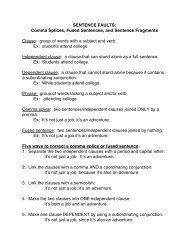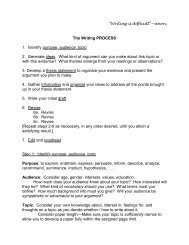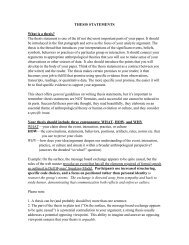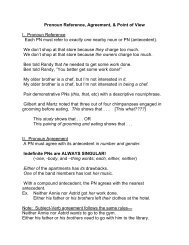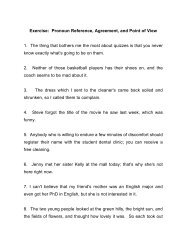Commas and Semicolons
Commas and Semicolons
Commas and Semicolons
- No tags were found...
You also want an ePaper? Increase the reach of your titles
YUMPU automatically turns print PDFs into web optimized ePapers that Google loves.
Ex. of direct address: Please, Janie, will you stop chewing on my book?(a few examples of ) When NOT to Use <strong>Commas</strong>1. Between subject <strong>and</strong> verbThe gorilla sitting in the corner of the cage thumped his chest.2. Before part of a compound structure that is not an independent clauseMark Twain trained as a printer <strong>and</strong> worked as a steamboat pilot.3. Between a verb <strong>and</strong> its complement or objectThe best gifts are food <strong>and</strong> clothes.4. After “such as”Popular fast-food items, such as hamburgers <strong>and</strong> hot dogs, tend tobe high in cholesterol.5. Before a clause beginning with “that”They warned us that the meeting would be difficult.TWO (<strong>and</strong> ONLY two!) reasons:When to Use a SEMICOLON (;)1. to link closely related independent clausesBiography tells us about the subject; biographers also tell us aboutthemselves.The results of the study support the hypothesis; however, furtherresearch with a variety of tasks is necessary.Remember that however <strong>and</strong> other transitional words are NOTcoordinating conjunctions <strong>and</strong> need a semicolon to properly join clauses.Other such words/phrases: therefore, similarly, in fact, certainly, next, etc.2. to separate items in a series containing other punctuationWhen I cleaned out the refrigerator, I found a chocolate cake, halfeaten;a can of tomato paste, which had a blue fungus growing onthe top; <strong>and</strong> some possibly edible meat loaf.




